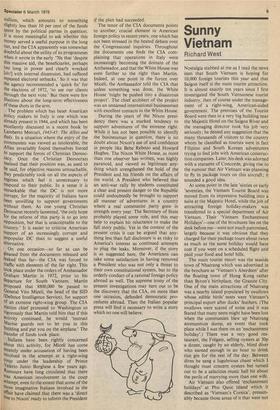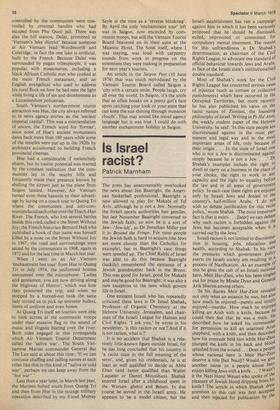Sunny Vietnam
Richard West
Nostalgia stabbed at me as I read the news item that South Vietnam is hoping for 10,000 foreign tourists this year and that Saigon itself is the main tourist attraction. It is almost exactly ten years since I first investigated the South Vietnamese tourist industry, then of course under the management of a right-wing, American-aided government. The premises of the Tourist Board were then in a very big building near the Majestic Hotel on the Saigon River and the managing director took his job very seriously; he denied any suggestion that the many thousands of visitors to the country whom he classified as tourists were in fact Filipino and South Korean adventurers trying to find jobs with American construction companies. Later, his desk was adorned with a statuette of Concorde, giving rise to the rumour that Air Vietnam was planning to fly in package tours on this aircraft ; it sounded a good idea.
At some point in the late 'sixties or early 'seventies, the Vietnam Tourist Board was moved from its impressive building into a suite at the Majestic Hotel, while the job of attracting foreign holiday-makers was transferred to a special department of Air Vietnam. Their 'Vietnam Enchantment Holidays'—one of the brochures lies on the desk before me—were not much patronised, largely because it was obvious that they charged for their package tours about twice as much as the same holiday would have cost if you went on a scheduled flight and paid your food and hotel bills.
The main tourist resort was the seaside town of Nhatrang which was advertised in the brochure as 'Vietnam's Aberdeen' after the floating town of Hong Kong rather than Byron's birthplace, the Granite City. One of the main attractions of Nhatrang was a nearby island populated by swallows whose edible birds' nests were Vietnam's principal export after ducks' feathers. (The swallows were scared of noise and it was feared that many nests might have been lost when the communists blew up Nhatrang ammunition dump, an event that took place while I was there on an 'enchantment holiday'.) There was a very good restaurant, the Frigate, selling oysters at 30p a dozen, caught by an elderly, blind diver who earned enough in an hour to drink rice gin for the rest of the day. Between dives he sang a lugubrious chant which I thought must concern oysters but turned out to be a salacious music hall hit about the perils of marrying more than one wife.
Air Vietnam also offered 'enchantment holidays' at Phu Quoc island which it described as 'Vietnam's Corsica', presumably because those areas of it that were not controlled by the communists were controlled by criminal bandits who had escaped from Phu Quoc jail. There was also the hill station, Dalat, promoted as 'Vietnam's lake district' because someone at Air Vietnam read Wordsworth and Coleridge; in fact the one lake is artificial, built by the French. Because Dalat was surrounded by pagan tribespeople, it was popular with missionaries, including a black African Catholic nun who cooked at the main French restaurant, and an English evangelical who used to address his rural flock on how he had seen the light while living a life of sin and drunkenness as a Leicestershire policeman.
South Vietnam's northernmost tourist attraction was Hue, the city always referred to in news agency stories as the 'ancient imperial capital'. This was a mistranslation of ancien, the French word for 'former', since none of Hue's ancient monuments dates back more than 180 years while some of the temples were put up in the 1920s by architects accustomed to building French provincial cinemas.
Hue had a considerable if melancholy charm, but its tourist potential was marred by the constant realisation that the communists lay in the nearby hills and frequently made their presence known by shelling the airport just as the plane from Saigon landed. However, Air Vietnam turned even these hazards to their advantage by laying on a coach tour to Quang Tri where the communists and anti-communists faced each other over the Thach-Han River. The French, who lost several battles beside this road, called it the Street Without Joy; the French historian Bernard Hall who published a book of that name was himself killed by a mine on the Street Without Joy in 1967; the road and surroundings were seized by the communists in 1968, again in 1972 and for the last time in March last year.
When I went on an Air Vietnam 'enchantment bus tour' from Hue to Quang Tri in July 1974, the uniformed hostess announced over the microphone: 'Ladies and gentlemen, you are now driving along the Highway of Horror', which was how they promoted the trip, and when we stopped by a burned-out tank the same lady invited us to pick up souvenir bullets, items of uniform and even bones.
At Quang Tri itself we tourists were able to look across at the communist troops under their massive flag to the sound of music and slogans blaring over the river. Both sides engaged in this propaganda which Air Vietnam Tourist Department called the 'saliva war'. The South Vietnamese Marine commander General Bui The Lan said at about this time: 'If we can continue chaffing and calling names at each other like this in this kind of "saliva or cold war", perhaps we can keep away from the "hot war".'
Less than a year later, in March last year, the Marines bolted south from Quang Tri and then from Hue in the strange military operation described by my friend Murray Sayle at the time as a 'reverse blitzkrieg'. By April the only 'enchantment tour' left was in Saigon, now encircled by communist troops, but still the Vietnam Tourist Board beavered on in their suite at the Majestic Hotel. The hotel itself, where I was staying, was loud with carpentry sounds from work in progress on the extensions they were making in preparation for next year's tourists.
An article in the Saigon Post (10 June 1974) that was much reproduced by the Vietnam Tourist Board called Saigon a 'city with a certain smile. People laugh, cry all over the world. In Saigon, it's the smile that so often breaks on a pretty girl's face upon catching your look or your stare that can keep the sun shining through monsoon clouds'. That may sound like travel agency language but it was true. I could do with another enchantment holiday in Saigon.



































 Previous page
Previous page